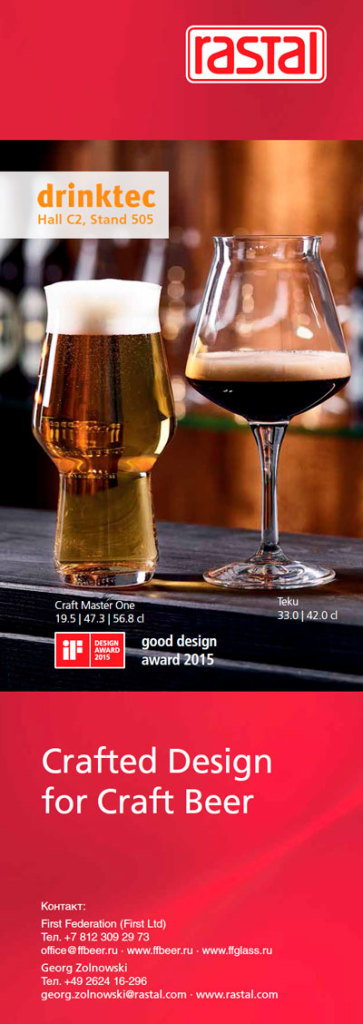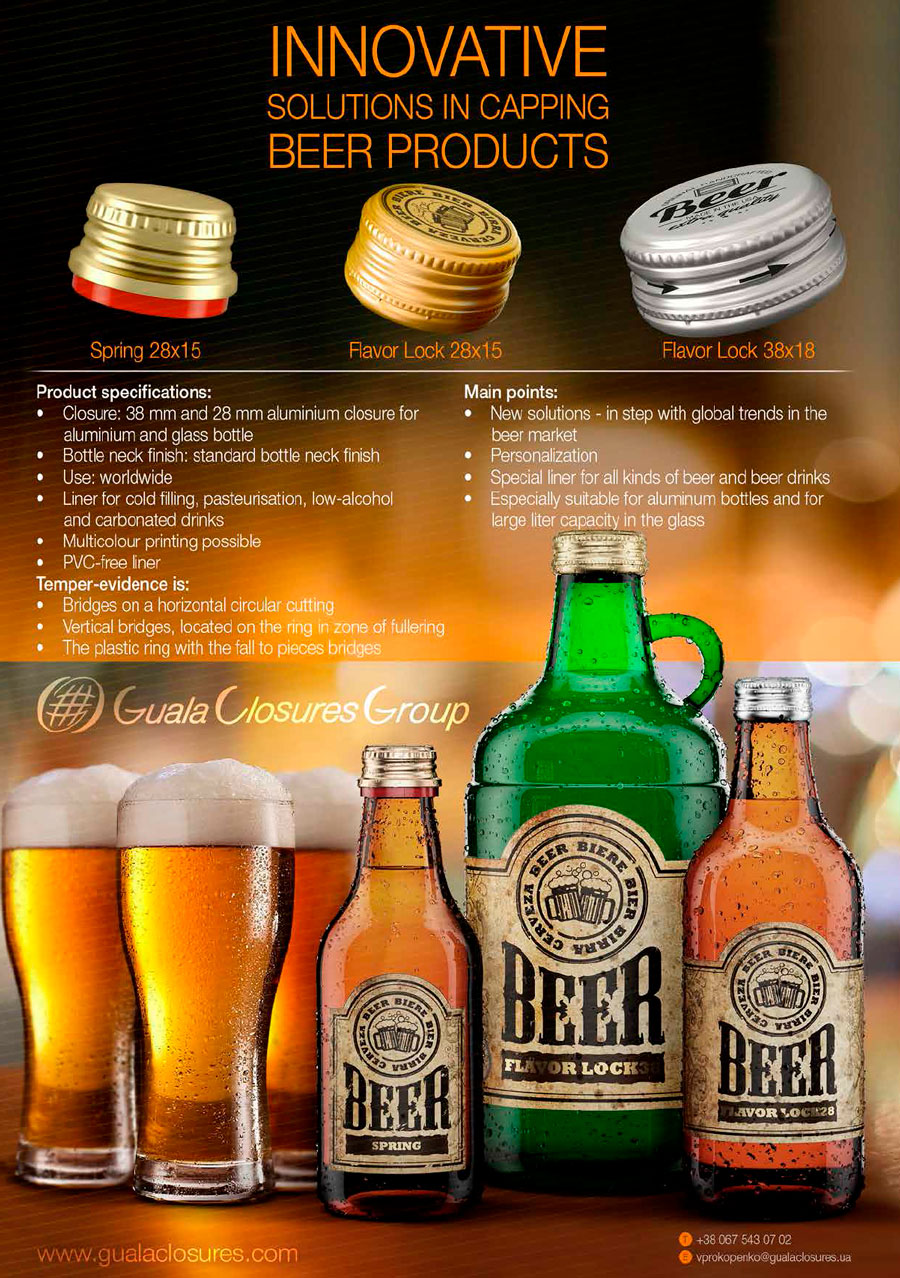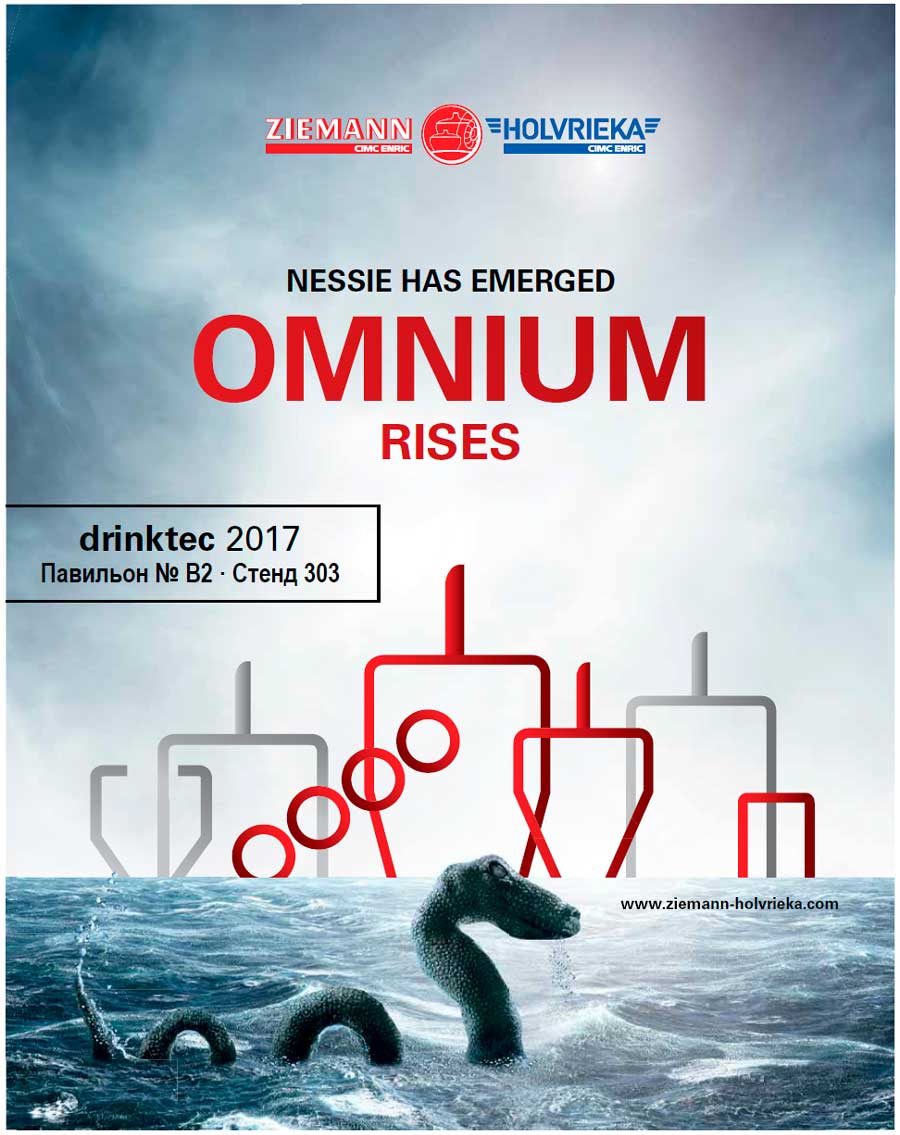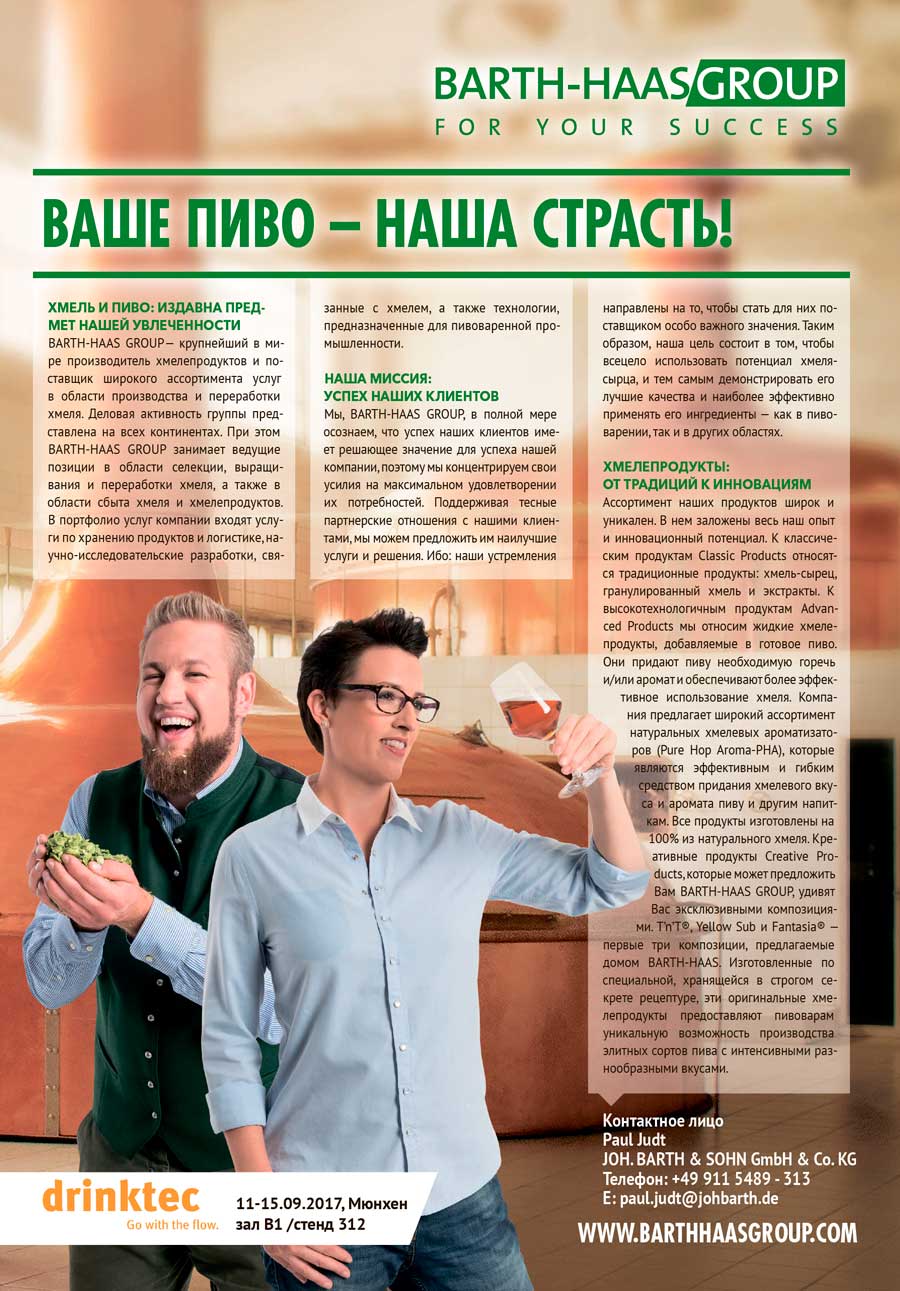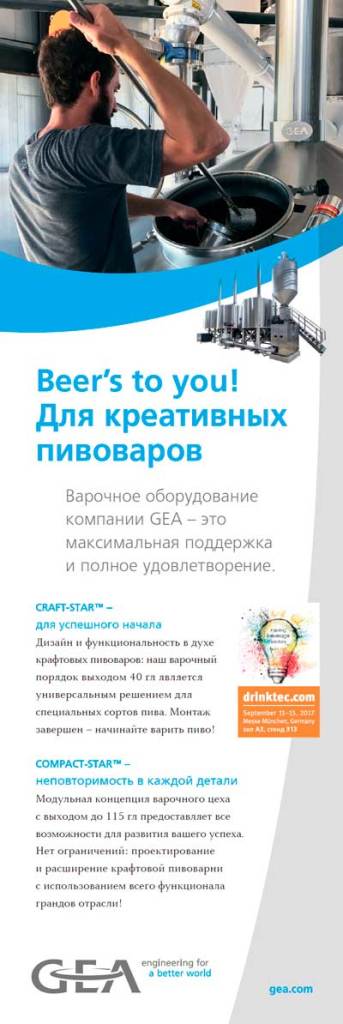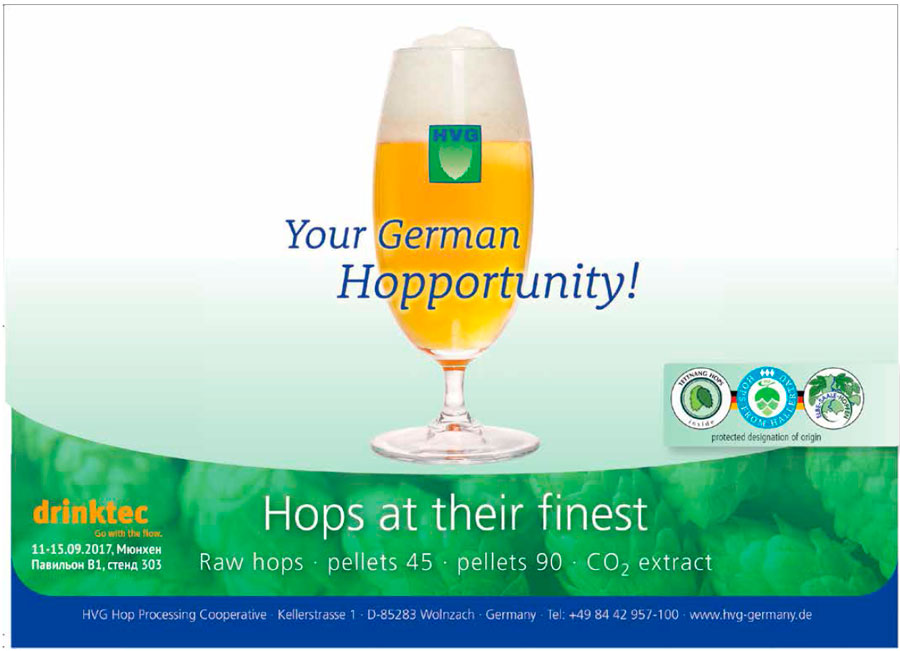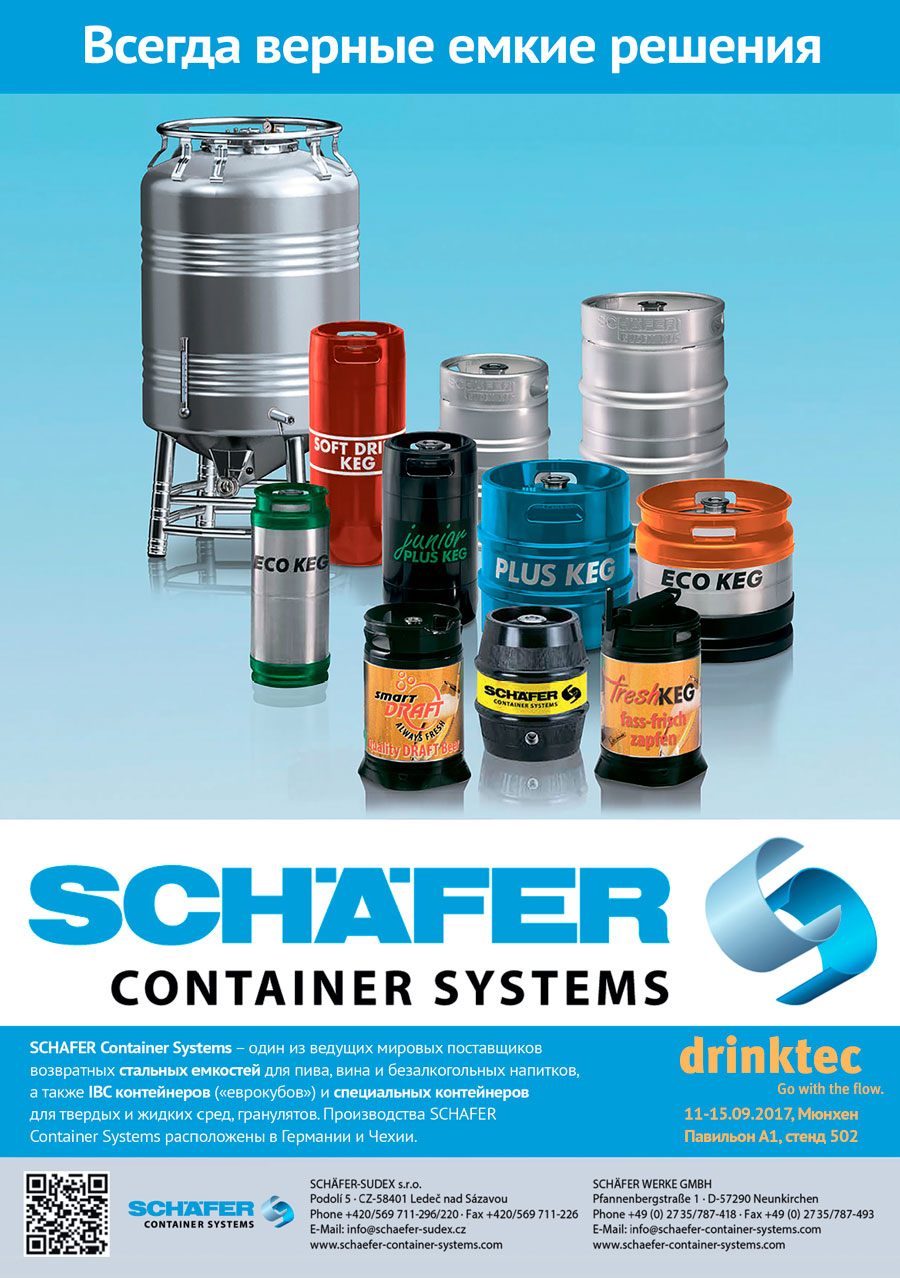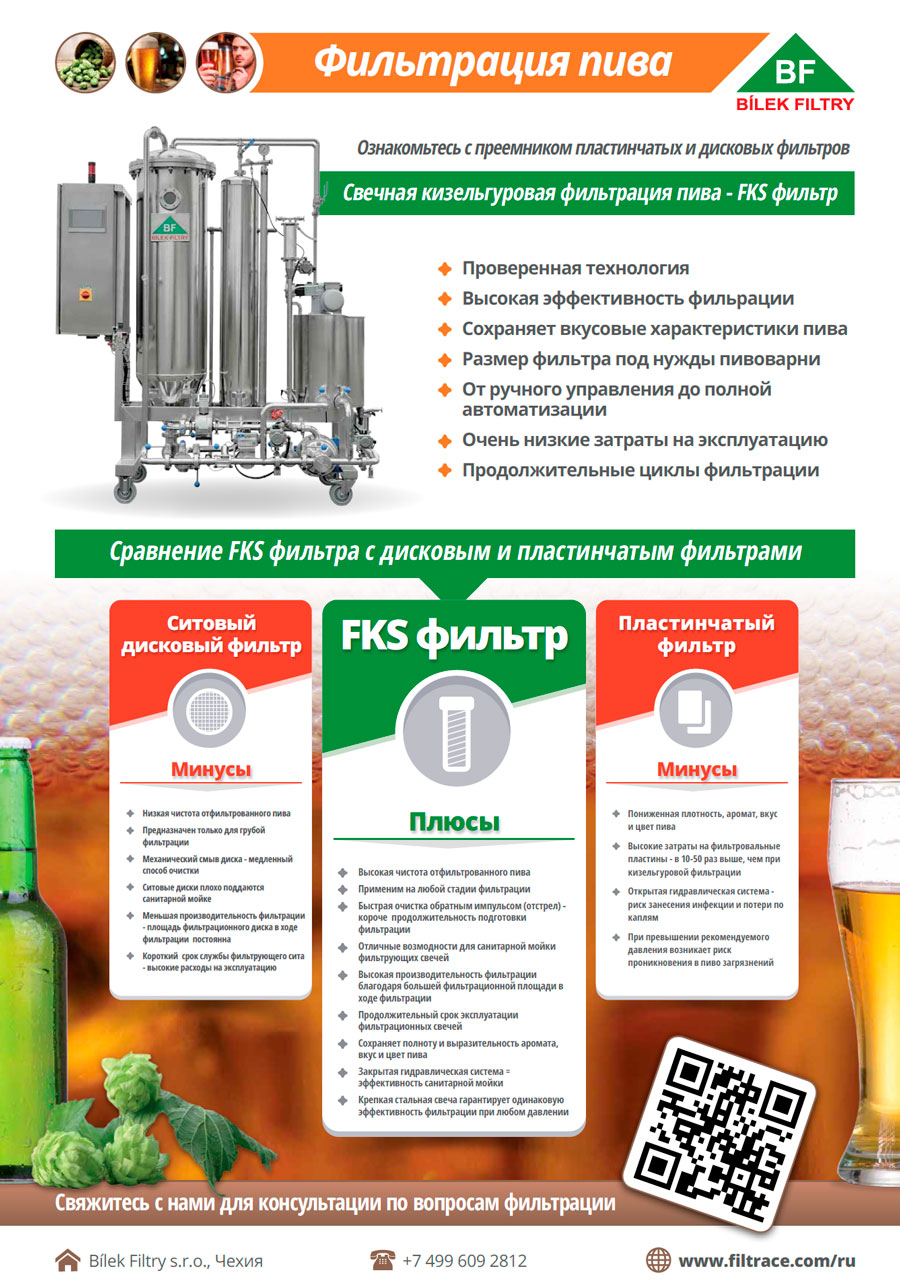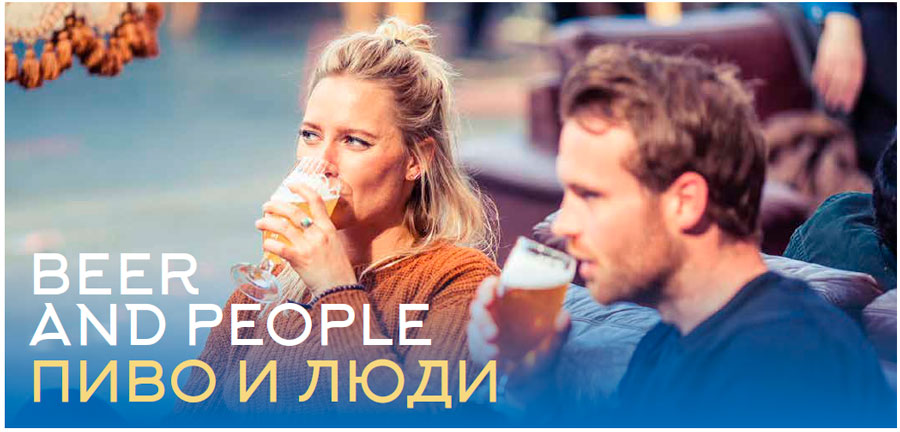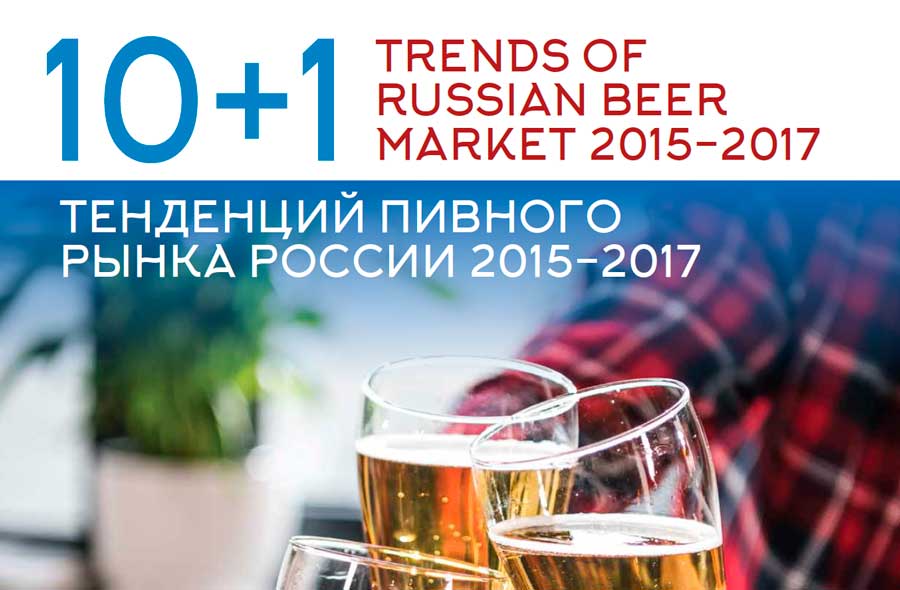
Despite of the moderately negative prognoses for 2017, the beer market can be stabilized soon. Yet the years of the negative dynamics have resulted in marketing being limited just to “optimization” and the art of balancing between price and volumes. Bigger supermarkets share means stronger trade marketing. These processes are connected to the majority of the described trends. At the same time, the federal brands inflation leads to searching for new tastes, sales channels and contact formats that expand the product range and diversify the beer market, but do not imply a substantial volume increase.
Let us enumerate and further discuss the ten trends of the beer market we can see in 2015-2017 as well as the major event of 2017.
- Weather is becoming the key factor for the beer market dynamics.
- Famous brands are stepping down the price ladder.
- The federal companies’ branding activity has declined considerably.
- The number of brands, sorts and separate SKU is decreasing.
- Brewers’ promotional activity in supermarkets is increasing.
- Multipacks are leaving the market.
- The decrease in frequency and volumes of consumption and active downsizing by brewers.
- The retail is increasingly more dominated by chains.
- Draft beer enjoys the popularity growth.
- Consumers, brewers, and traders show interest to HoReCa.
Besides, in the coming years, the competitive situation will be greatly influenced by integration process of Efes and AB InBev.
Во второй части статьи мы расскажем, как стиль жизни, уверенность в завтрашнем дне и социальные сети повлияли на потребление пива в России.
In the second part of the article we will discuss how lifestyle, sense of security and SNSs influenced beer consumption in Russia.
- Who drinks beer in Russia and how much is drunk?
- Healthy lifestyle and beer
- You can’t get a drink in SNS
- Social adaptation and beer
- Structure of alcohol consumption
Market is following thermometer
The final numbers of the beer output volumes for the first 5 months of 2017 offered hope. At first, the market stabilized and then the dynamics became positive. However, at the summer beginning the beer sales fell off. The production growth by 6.3% in May 2017, gave way to a 11.7% decline in June.

The weather was the main driver for the positive dynamics last year. The soaring growth of beer sales and production in July-August 2016, allowed brewers if not gaining profit then at least keeping at the level with the previous year results.
Low temperature in June 2017 had a disastrous effect on the results of the first half of 2017. The negative dynamics of beer sales were reported about by federal and regional companies that had been developing better than the market and representatives of federal trade chains.
In particular, by Baltika’s assessments, during the first six months of 2017, Russian beer market went on falling, and went down by 5%. The negative dynamics was caused by production and turnover limitations (except for retail sale) on beer in PET of more than 1.5 l. that came to force on 1 January 2017, as well as by unfavorable weather conditions in several regions of the country and continuing decline of the actual incomes of population.
At company Bulgarpivo complained that the statistics of sales … in June equaled the summer weather in central Russia. Neither summer season nor sales season of drinks has been started yet. After spectacular sales volumes in 2015-2016, now the company has returned to the figures they had 3-4 years ago. In all fairness it must be added that two previous autumns were exclusively warm.
Dmitri Medvedev, marketing director of trade chain Perekrestok said to RNS: “Due to cold and rainy weather in European part of Russia in June, sales of alcohol-free beverages and ice-cream went down but not more than by 10%. At the same time, we can see that strong alcohol has grown more popular than last summer”.
Vladimir Rusanov, Diksi representative also told about decrease in sales of beer and ice-cream: “Compared to May-June of the last year, the sales of ice-cream and soft drinks in numerical terms declined by 15% at the average and beer sales lost 5%” – he said.
Maria Kurnosova, communication manager of Retailer Auchan in Russia noted that by the end of June the sales volume of barbecue, beer, and soft drinks in Auchan store decreased against the last year figures. “The cold summer has had an adverse effect on the sales volume of barbecue, beer, and soft drinks in Auchan stores in Russia. By the end of June, these categories show decline against the same period of 2016” said Ms Kurnosova.
By the end of the first half of 2017, the output dynamics remains positive with a 1% growth. Yet, due to the high base of the third quarter of 2016, when the temperature in many regions was abnormally high, the dynamics of the third quarter of 2017 is not likely to be positive. By the year end, we should expect sales reduction in the territory from the Central region to the Ural inclusively, unless the weather becomes hot again or there arise other positive factors.
The market attaining balance means that the seasonal fluctuations will be more influential for the sales dynamics than earlier when they were of secondary importance.
Price migration of national brands
In recent years, there has been a large-scale process of moving a number of major national brands to lower price levels. The process was caused by falling sales and regional breweries attracting consumers who buy economy and mid-price beer.
The most markedly affected were national economy brands. Since 2015, dramatic reduction of the market share was faced by such beer brands: … and … by Heineken, … by Efes, …, … and … by Carlsberg Group, … by AB InBev, …by Ochakovo.
The pressure imposed on economy and mid-price segments by regional beer led to a revision in the positioning of sorts and brands of international companies. The definition of “mainstream segment”, i.e. mass–market beer, which is sold in retail networks, is not anymore applicable to mid-price, but to economy market segment.
The most substantial price migration in 2014-2015 was the move to the economy segment of … and …, the largest brands that are included in TOP-5 by sales volumes, but which have been losing market share for a long time. This process, along with the growth of sales of … by Carlsberg Group and many brands of regional manufacturers provided stability for the economy segment in the retail beer market.
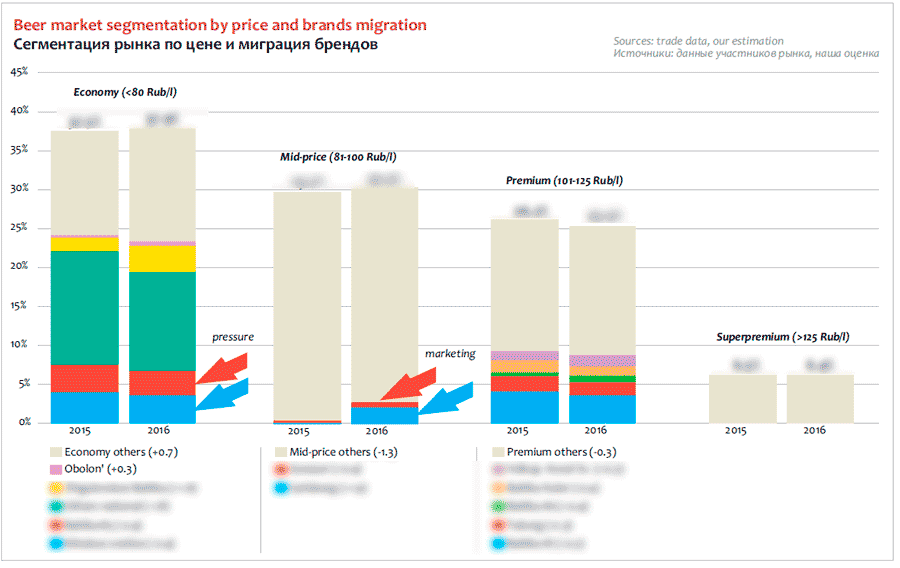
For a long period of time, the decline in sales of mass brands has been driving the narrowing of mid-price segment, but now the vacant position is occupied by “premium” and international license brands that are also becoming more affordable.
In this way, great growth in 2015 was shown by three licensed brands, which significantly reduced cost and increased distribution: the … by Carlsberg Group, … by Heineken and …by Efes. As a result, today’s positioning of … and … corresponds to the mid-price segment. Retail price of the largest licensed brand, …, corresponds to the boundary of mid-price and premium segments.
Note that Efes company has also reduced the average retail price on their mid-price Russian brands – … and …, which along with the active growth in retail chains has allowed them to increase market share. The market share of … by Heineken was also stable.
The result of the superposition of all these processes was the growth of mid-price segment and the reduction of the premium. The most affected were Russian brands positioned on the border of mid-price and premium segments. In particular, … and … from Carlsberg Group significantly reduced the market share (sales growth of …was not able to compensate for their volume). In addition, sales of … by AB InBev have been decreasing for a long time.
Branding of craft scale
Due to the beer market decreasing and excessively effective branding activity of the recent years, starting from nearly 2015, the market leaders have been outputting new sorts, not daring to introduce new brands. The popularity of craft draft beer determined the key focus in marketers’ and major brewers’ creativity.
On the one hand, there are local launches of popular import brands. For example, “MBC” in 2015, started making Japanese brand Kirin, and in March 2016 – Finnish beer Lapin Kulta. In May 2017, company Heineken launched Belgium ale Afflingem, which seems to have become a member of its international portfolio.
On the other hand, there are just a handful of new brands with federal distribution, that were not known to the Russian consumer before.
The market leader Carlsberg Group in 2015 launched Neon Beer. The new brand is obviously intended to compensate for the down trend of Tuborg, as their price and target audience in general coincide. The youth focusing and club style of Neon Beer are supported by the high tech design, darkness glow and low density of the beer. Under the market players’ estimations, the share of Neon Beer has reached several tenths of a percentage point.
Besides, Carlsberg’s portfolio in 2015 got several draft brands, namely Peterhof and Česky Kabanček and regional brands, i.e. Sverdlovskoe, Zapovednoe, Samara Cheshskiy khmel, with the distribution of beer Zapovednoe having crossed the boarder of the local region.
Company Efes, which used to be the major newsmaker and stood out for a lot of launches, has also suppressed its branding activity, working on its portfolio rearranging and only seldom introduced new sorts of existing brands. In summer 2015, it launched mid-price draft beer “54” distributed only within the Siberia region. 2016 saw no new brands launched.
Instead, in spring 2017, the company inspired by the popularity of craft beer, output premium beer Tverdiy Znak brewed with hop Citra for “fulfilled man”. Previously, in 2014, there were efforts to enter the craft territory with beer “387” which stuck out with its garage design.
Company Heineken, within the strategy of promoting its global portfolio in 2016 started local production of Tiger lager, which had not been known to the Russian consumer before. The brand belongs to the premium segment and is distributed in big cities. Despite the increasing interest to the Asian culture and promotion, the market share came to … by the end of 2016 and further prospects of the brand look vague.
Company AB InBev went only as far as outputting new sorts of existing brands, having launched a range of additional “craft” tastes of Sibirskaya Korona.
The major trendsetter was Moscow Brewing Company that has expanded its portfolio at all price levels over the recent years. In line with their tradition of outputting brands with a background, in 2015, MBC brought back two well-known brands.
License launch of beer Obolon has given a new impetus to sales, which made the brand the key economy beer in the company portfolio. By the end of 2017, the brand’s market share can reach …%, which roughly equals the volumes of Obolon at the time of import supplies.
Another novelty of this kind was brand Fifth Ocean, which however, has changed the image. Remaining an undoubtedly premium niche sort, it has turned from lager into ale and moved from mobile tanks to 0.75 l bottles for after-fermentation.
Volkovskaya Pivovarnya, that was spoken about in issue 2-2017 was the third new event of 2015, being not just beer but a craft project.
New brand Khalzan output by Ochakovo in April 2016, showed an unexpectedly dynamic growth. An eye-catching and rather affordable brand, that targeted young consumers was quick to win nearly …% of the market. Apart from the low price, quite sharp-witted brand package picturing a bird-man with an axe against a backdrop of mountains has made a big contribution into the brand success. It fuses together images of “American freedom”, super power heroes, Eurasian name, and popular in beer branding animalism.
Product range optimization
The beer market declining, branding activity reduction, and ad’s orientation at mass brands were logically followed by product range optimization that excluded ineffective SKU, sorts and brands. Besides, at the threshold of the prohibition, in 2016, goods items in large volume PET package started leaving the turnover.
Two companies, Carlsberg Group and Efes were reducing most rapidly their ranges, as they look disproportionally big against their market share. Carlsberg Group was striving to be widely represented in all segments and formats, during the market growth period. Efes has obtained a wide brand portfolio together with SABMiller assets and still has continued actively launching new sorts to the market.
Not only certain SKU and sorts but also widely known brands started disappearing from the federal retail network. Thus, Efes is obviously excluding marginal brands … and … as well as economy brands … and … from their product range (by the way their names disappeared from the company website). Carlsberg Group is taking marginal brands … and … out of their product range. This is probably not the full list.
AB InBev and Heineken have obviously already carried out the main optimization of the national portfolio, and at the moment, they are revising the regional brands. For example, there was a sharp decline or a complete stop of beer … and … by Heineken.
Companies MPC and Ochakovo as well as many other regional companies on the contrary are expanding their product range rather than decreasing it.
Beer and promo
Promotional activity is growing in virtually all food categories, and beer is trying not to be behind. Consumers’ attention to profitable offers and notable price fluctuations remains very high, which leads to the popularity of promo offerings.
In 2016, according to market players’ info, the share of beer sold at discounts grew by several times, having come to almost …% of the total volume of this category retail sales in supermarkets (in 2015 this figure equaled roughly a … of sales).This is less than carbonated drinks but much more compared to fast food and snacks to beer.
During 2016, the promotional activity was increasing and achieved its peak by the autumn beginning. At certain moment, about a … of sold beer was at a discount. The weather played its part being very hot in summer and quite cool in September. Brewers had to sell accumulated “by inertia” surplus of beer at the conditions of sever price competition.
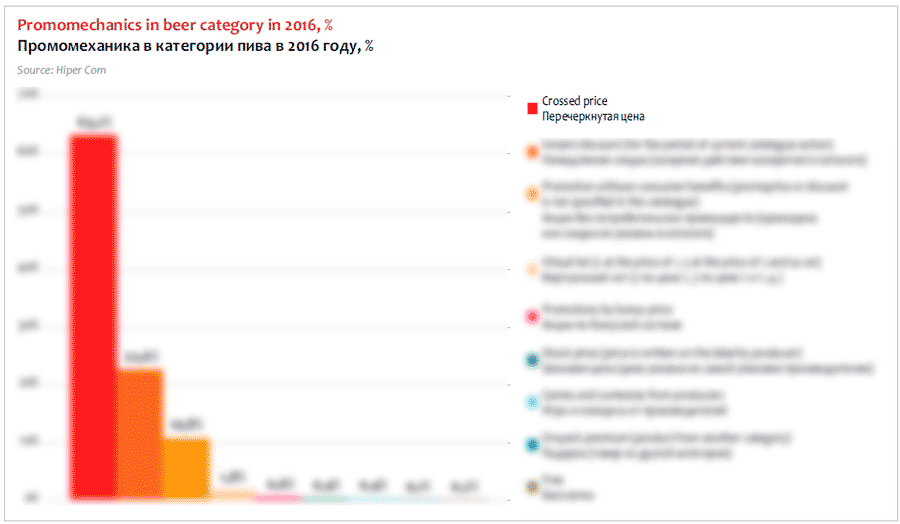
By the data by research company Hiper Com the beer category reached nearly … thousand of unique “promos” in 2016. The most popular were “crossed price” and “instant discount” having shares … and …% accordingly. Usually the discount amounts to …-…%. And the maximum discount was …% with a coupon at hand.
Beer promotional actions are almost fully limited by the boarder of modern sales channels, hardly present at the traditional retail and the channels of impulsive demand. By the data of Hyper Com, over 2016, almost half of discounts by …-…% was given by trade networks of supermarket format. The second place occupied discounters and the third one – hypermarkets.
According to market players’ estimations, the promotional activity of brewing companies was connected to their price policy and brand positioning. For example, in 2015-2016, … and … were much more active compared to their competitors in increasing the retail prices, which includes sales structure changes. Obviously having profitability in mind, the companies were striving to compensate the natural volumes decline. But then, in order not to lose consumers, … and … were more active than … and … in promotions. Heineken was especially involved into this process in autumn 2016.
However, some regional breweries, which work at the draft beer market also sometimes have to attract buyers by big discounts, setting prices at the profitability boarder or even lower than the self price in order to keep the market share and the production load.
The promotional activity increase in the alcohol category has already attracted the authorities’ attention. In February 2017, Vladimir Sysoev, LDPR deputy of Duma introduced an initiative to prohibit discount offers for alcohol. This proposition was supported by Anna Popova, the head of Rospotrebnadzor. There has not been any information concerning further progress of the idea.
Multipacks were unpacked
The prospect of selling multiple products at once and getting additional advertising space makes multipacks attractive for the manufacturer. In Russia this packaging format in the vast majority of cases is represented by canned beer held together by heat-shrink wrap. Bright and eco-friendly cardboard packaging of bottled beers, expensive to manufacture and more complicated to place on the shelf, has not yet really caught on in Eastern Europe.
The use of multipacks in special promotions, for example “3+1” where the gain is obvious to the consumer, makes the purchase rational. However, in 2016 a more straightforward promotions with explicit benefits have become the main method of sales stimulation (see Chapter “Beer and promo”) replacing the “3+1”. However the price of beer in multipacks has become almost equal to the average price of the same quantity beer in cans.
But how big are the benefits of purchasing the multipack to the consumer? Convenient carrying and compact storage of several beer cans are not so significant. Buying the multipack at full cost, per se, attracts few beer lovers nowadays.
So gradually multipacks have been driven away from circulation, although didn’t disappear completely. Group packaging was most actively used by company … for their popular mass brands and … for … . So in 2016, the same companies made a major contribution to the reduction of the multipacks market share.
Consent Downsizing
In recent years, downsizing, decreasing the package by manufacturers with no price change, has become a large-scale phenomenon. This process would not be given a lot of attention, but downsizing has a negative impact on beer sales by volume and market share of companies, however, without affecting the size of the market and sales by value.
There are several serious reasons for large-scale downsizing. It is the brewers’ desire to control retail prices, but not at the expense of their revenues, the prohibition on beer in PET with a volume over 1.5 liters, and also the fact that people themselves are gradually reducing the amount of a one-time beer consumption.
According to market participants, while in 2014 the volume of beer sales in downsized packaging was about …%, in 2015 about …% of beer was sold in it, and by the end of 2016 about …%. As the reduction of packaging at the market averages …%, the negative contribution of downsizing for retail beer sales in 2014-2016 is estimated at …%.
The main initiators of using downsized packaging were … and …, that actively implemented downsizing not only for PET, but also for cans and glass bottles. Each of these companies could have lost approximately …% of market share by volume within two years. To a lesser extent the process of downsizing was conducted by …, which started to reduce PET packaging in 2016 and … (back in 2015).
Within two years the expansion of downsizing has led to transition into a smaller volume of nearly …of beer in PET, about …% of beer in glass bottles and just over …% of beer in cans.

Beer in PET packaging was more affected by downsizing due to the introduction of restrictions on the sale of beer in bottles over 1.5 liters, which was reduced to 1.4-1.45 liters. Even greater was the impact of a forced transition of beer from larger PET packs into this size of container.
But this effect will manifest itself to the full extent only at the end of 2017, as complete sale ban came into force only in the second half of the year. Large companies began to accustom the consumer to a smaller container in advance, back in 2016, but this temporarily formed niche was filled by regional beer producers that increased sales on a one-off basis.
We think, from the point of view of consumer reaction, downsizing had the most negative impact on affordable beer in PET. Buyers of this beer often want to get the greatest volume of product for their money and can perceive volume reduction as a veiled attempt to deceive them. Moreover, when buying beer in PET in connection with a variety of containers, usually it was a question of choosing the package volume that is specified additionally. Beer in cans and glass bottles are often bought for the taste and “process”.
Interestingly, downsizing in general coincided with the trend of changing consumer behavior. The Russians have the tendency of reducing the frequency and volume of beer consumption.
Since 2015, the proportion of beer consumers who drink often and a lot at once, has decreased (before this process was slower). But simultaneously the share of “beer lovers” drinking less and less often has increased. In addition, people who drank small quantity of beer have quickly reduced the frequency of consumption.
The group of people who drink a lot of beer not only hasn’t got an influx of young beer lovers, but even faced a reverse process. In addition, despite the fact that people with more money drink more beer, the group of people that have improved their financial situation has experienced a gradual increase of the percentage of those who did not drink beer for the reporting month or gave up alcohol altogether. Thus, both the young and the wealthy, in general, are not against volume reduction.
Obviously, we see a trend towards choosing smaller volumes or giving up beer in most groups. This trend coincides with the increased use of downsizing by beer manufacturers. However, taking into account the decreased frequency of consumption, volume reduction has a multiplying effect. In this way, such negative synergy has led to market contraction by a few percent in recent years, if we consider the consumer aspect.
Along with the downsizing, the beer package volumes also decrease due to the popularity growth of 0.33 cans. According to market players’ data among standard volumes, their share has increased the fastest in 2016.
Modern trade power
We have considered the development of marketing chains in detail in issue 2-2017, but we should discuss the modern trade again as here we have a most important long-term trend.
Modern trade today is not only the biggest beer distribution channel, it is also the most promising one as it is the only one to demonstrate a growth, though not rapid but rather stable. The beer sales decline in traditional groceries has been progressing by two-digit rates because of their number decrease and stronger consumers’ rationalism which means sticking to planned purchases at supermarkets in order to economize.
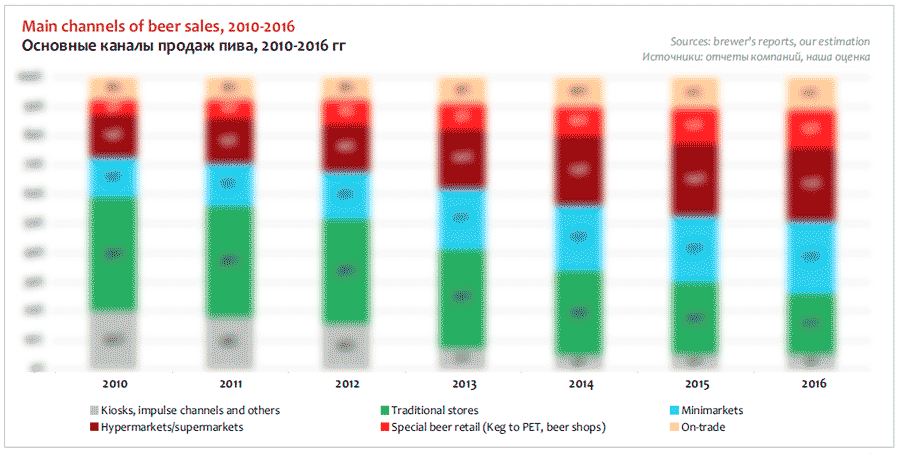
According to brewing companies’ reports, in 2013, traditional outlets sold twice bigger beer volumes than the modern trade. Yet, the ban on beer sale in kiosks and riot growth of chains over 2014 changed the situation for their favor. According to the results of 2016, the modern trade formats in the total volumes of retail beer sales grew by nearly … p.p. and reached about …%. Non-chain shops and other traditional retail currently account for a little more than a … of the total beer sales.
The redistribution was particularly rapid in the first half of 2016. While in Siberia, Far East, and the South there is still some parity between beer sales at the retail trade formats, in Ural and Volga regions, to say nothing of the Central and North-Western the traditional shops now account for nearly …% of beer sales.
Major companies Carlsberg, Efes, and Heineken have been most actively cutting down their market presence at traditional shops due to SKU reduction and under the pressure of other producers. Judging by the two market leaders’ reports they purposefully focused on sales increase at supermarkets. Good performance of MBC in 2016 was achieved among others by intensive growth in the regional chain retail.
Unlike the market leaders, regional brewers were developing quite steadily in all channels of retail. They have increased their weight at traditional shops greatly pressing federal brands. The same process but to a lesser extent was taking place in the modern trade. For example, a range of medium sized enterprises including …, … and many other Siberian breweries have considerably strengthened their presence in Ural region. By the way brewery … also had an excellent performance in other regions of Russia.
On the one hand, medium breweries pressed the market leaders in small towns, where there are still many traditional groceries. On the other hand, as we have already said, the growth of regional breweries was much based on large PET package which will be forbidden to sell in retail starting from this summer. So it is uncertain whether it will be possible for them to further increase their share in modern trade in 2017.
At the end of 2016, all brewers got a chance to strengthen their presence in chains, yet there appeared a risk of losing their shelf spaces. According to new amendments to “Trade Act” networks are not allowed to take any fees beside a 5% bonus for services or of volume sold production from suppliers. As a result contracts are being revised and the purchasing prices are growing in order to compensate for the traders’ loss of profit. And even the beer market leaders sometimes failed to reach a compromise and conclude contracts with all previous partners.
Draft regional
Regional breweries this year will probably grow if not stopped by weather conditions. Yet strengthening the positions of medium breweries is a long-term trend. Their development is driven by high interest of consumers, specialized retail growth as well as by local authorities. Amid the difficult economic conditions, excises and indirect effect of the economic activity of brewers have become an important federal budget raising item.
While federal companies managed to stabilize their sales thanks to supermarkets, regional producers rely on the specialized retail. Beer sales in kegs at draft beer shops is their major outlet channel accounting for already almost half of sales. However, the growing draft segment is exerting ever stronger pressure on the market of packed beer, where regional brands are also gaining market weight.
According to 2GIS data by July 2017, in 85 cities of Russia there were … draft beer shops. Moscow leads by the number of outlets (… shops), the second place is taken by Saint Petersburg (… shops), and the third place is Novosibirsk (…) that can be considered the native land of draft beer.
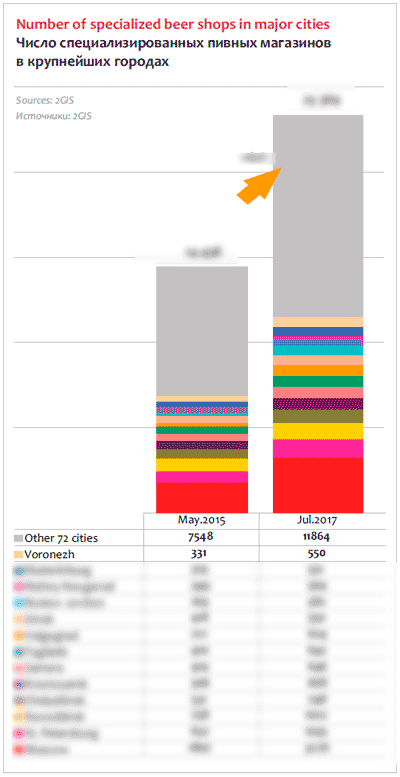
Basing on the population number of the cities included in the calculations (65 mln people) at the average, there are … specialized outlets per 100 000 people. Let us note that in May 2015, according to 2GIS there were … shops of draft beer, that is, … times less.
Such a sharp increase of the shops number against 2015 can be explained by wider geography of the nose count by 2GIS as small neighboring towns were included. Besides, the list was expanded by alcomarkets, which, though do not specialize in beer, sell it too. For example, one of the biggest Russian chains “Red&White” that is aggressively developing and have … of outlets. Beer accounts for 100 out of more than 700 items in the alcoholic product range.
Regardless of the assessment method, the rapid increase of the outlets number is obvious. And today in big cities, the main competition is taking place not so much between separate outlets as between chains. Their customers usually know their way in beer tastes, preferring alternative and fresh beer to mass brands with a long shelf life. And the draft beer market is developing due to local brands growth rather than scaling up. Dozens of medium breweries expanded their share in 2016, having done reconstruction, increased capacity and became considerable local players.
…% of sales of the majority of medium breweries is accounted for by their home region. Concentration on a limited area, lack of pressure from supermarkets and increasing turnover even allowed some medium breweries to reduce retail prices for draft beer in 2016.
Beer shops take efforts to form their individual product mix, including beer made locally. So the specificity of the draft segment is a considerable difference of product range from one region to another. The leading positions at the draft beer market are taken by Siberian producers: …, …, … as well as by … that has been growing rapidly over the recent years.
Yet the main increase in sales and market share was achieved by independent brewers on the territory from the Central region to Ural due to the extremely hot weather (on the contrary, in Siberia it was cool). Company … saw its share grow in Moscow region, and … and … demonstrate the best performance in Ural and South region respectively.
If we consider the market situation by brands, we will see a decrease in the draft market share of Zhigulevskoe by Heineken, while there was a sales growth of this people’s brand by Zhiguli brewery. At Tomskoe pivo the market share growth of new sort … is taking place amid the reduction of “old brands”. There is a dynamic sales growth of beer … by the brewery of the same name, of beer … (by NZIV, Novosibirsk region), … (Barnaul brewery) and dozens of other brands.
Trehsosensky brewery saw their sales rise in a number of region, being one of the most dynamically growing companies last year, however, this company focused not on draft beer but on packed beer.
The last year base effect will most probably lead to a mirror reflection situation, that is, will not let regional producers in the West of the country raise their sales by the end of the year and possible cause the growth of breweries in Siberia. This year, in order to assess the performance of regional breweries, one should look at the local market share.
Federal companies are trying to play on the same field with regional breweries by launching new draft sorts on the market. Here the most active was Carlsberg Group, that in 2015 had a quiet launch of beer …, and of … in 2016. The both brands are affordable, non-filtered, and packed in kegs to be delivered to draft beer shops.
In 2017, on the basis of Voronezh branch, “tank beer” project was started. A special car delivers beer to outlets. There it is stored in sterile packets in steel tanks of 500 liters. By the time of the article preparation, 30 outlets were equipped with tanks in different district of Voronezh. And by the end of July, it was planned to increase this number to 50. The tanks are filled with sort “Voronezhskoe Zhigulevskoe”. The lifespan of the beer in tanks cannot exceed one month.
Direction – to bar
The piling burthen of bans in retail beer trade and forming traditions of alcohol consumption in HoReCa increase the significance of beer pubs. Besides, the brewers increasingly employ them as places for contacts between consumer and brands. We can note that restaurants as a format are becoming more and more interesting for beer consumers, brewers and traders.

In particular, we can say that people are gradually developing a habit of consumption in HoReCa. RLMS-HSE surveys reflect a long-term trend of growth in the respondents’ share who drink alcohol at bars and restaurants (among those who consume alcohol). Over 7 years, their share has grown by approximately … p.p. and currently amounts to about a quarter of alcohol consumers. Let us remind that the surveys are regularly held during winter time.

The groups of those who drink alcohol at restaurants and those who prefer some other places, are different by their lineup from the point of view of volumes of beer consumption. Besides, the differences are seen both in statistical and dynamical cross-sections.
Among the respondents who like drinking alcohol at restaurants, there were fewer of those who drank much over the reporting month. So, the trend of decreasing in number of those who drink much beer is obvious.
And on the contrary, among those who do not consume much beer at restaurants, the share of those who drank much over the reporting month is gradually growing. As a result, in this group there are more people drinking much beer, than among pub and restaurant-goers.
As there are more wealthy people among restaurant customers, this trend is in general in tune with the other one, namely, the outrunning decrease in the number of consumers and beer consumption volumes in the group of people with big incomes. Besides, this sociologic picture is logically complete with higher popularity of expensive craft beer, which is consumed at small volumes.
Another aspect of HoReCa development is connected with producers’ interest. Recently, we have much heard about branded pubs opening both by regional (Bochkari, Kalinkino and others) and international brewing companies.
In April 2017, Efes launched a project of “tank” beer, which combines ideas of mobile tanks of secondary cask fermentation and using of horizontal containers for restaurant breweries.
Unpasteurized beer is poured into transport tank to be delivered to a bar. There beer without air or light contacting is poured into a stationary tank, where it is stored for up to seven days. The project of tank beer was started at two Moscow restaurants Kozlovitsa. In the nearest future, it is planned to open restaurants with a pre-planned space for tank equipment. According to the company message, before the year end, three more beer restaurants Kozlovitsa with tank beer will join the project.
Another original project of 2017 is a seasonal Shikhan Grill Bar opened by Heineken in Ufa. The company made up a concept of a democratic summer bar, its interior and menu. It mostly contains production by Heineken brewery in Sterlitamak and certainly, Shikhan brand, which accounts for almost 20% of the beer market in Bashkortostan republic.
Besides, consumption at HoReCa is promoted by entrepreneurs selling beer. At regional markets in 2014-2015, there has arisen a trend, when instead of specialized draft beer shops, small beer pubs are opened. In the first place, their appearance is connected to introduction of temporary limitations on retail trade of alcohol. However, the flow of draft beer from retail to public catering does not mean a sharp increase in the number of outlets.
AB InBev-Efes 2018
In August 2017, AB InBev and Anadolu Efes concluded an agreement of intent to join their businesses in Russia and Ukraine in equal shares. This decision resulted from the merger of AB InBev and SABMiller completed in October 2016, when AB InBev received 24% of the Turkish group’s shares.
On the deal conclusion, the joined company will consolidate its performances in reports of Anadolu Efes. In its turn, AB InBev will not include them into their global repots but will take into account their part of obtained revenues.
Soon-to-be name for the joined company is AB InBev-Efes. The board of directors will consist of representatives of the both companies in 50:50 proportion. Candidacy of Tundzhai Ozilkhan, chairman of the board at Anadolu Group is considered for the position of the joined company’s board chairman. The companies have principally agreed on assigning Dmitry Shpakov (currently, president of business subdivisions of AB InBev in Russia and Ukraine) for the position of president of the joined company. Roi Kornish, CEO at Efes Rus will take the position of financial director.
The deal is expected to be concluded by the end of the first half year of 2018. All changes will come to force after completing transaction, prior to that, AB InBev and Anadolu Efes will be operating as independent businesses.
The terms of the agreement of intent are not disclosed.
Basing on the past experience of alliance with SABMiller as well on AB InBev priorities (whose shareholders are not likely to find the markets of the Eastern Europe attractive) we can expect the key role in the joined business to be played by company Efes.
By simple summing of the two companies’ market shares, we will see that they account for a quarter (24.6%) of beer sales in Russia. As under our estimation Efes market share in 2016 amounted to 13.3% and AB InBev had 11.4%.
AB InBev positions have been falling for a long time, while Efes’s share has been fluctuating but still growing recently. The joined company will considerably reduce the gap to Carlsberg Group, the share of which in 2016 amounted 31.4%, and probably will decline in 2017. Yet in view of the coming integration processes, one should hardly expect the leader change in the foreseeable future.

After the assets joining, the company will get a portfolio of brands that will be too big even for the aggregated market share. For example, in the Russian portfolio of Carlsberg Group we can roughly enumerate about … big federal brands including numbered sorts of Baltika. AB InBev and Efes have about … such brands each. In the course of inevitable optimization, more promising brands with a large market share at the top price segments are likely to survive.
The sale structures of AB Inbev and Efes by the price segments are a little different. When one of the major Russian brands, beer …, was pressed out to the economy segment of the beer market, the economy part of the company portfolio grew bigger compared to other leaders. This process in 2015 was also fueled by a successful launch of sort … in small PET-package, though currently the brand’s share has decreased.
At the same time, Efes purposefully and under the pressure of the competitive situation has decreased the share of cheap beer in their portfolio, also by cutting the number of brands, focusing only on their key brand, namely, …. Thus, the optimization and reduction of the net market share of economy brands among which …, …, and joined … will stay, is most probably continue.
By active cooperation with modern trade and rather restrained price policy, Efes managed to increase the market share of their marginal brands and, accordingly, to enforce the marginal and premium parts of the portfolio. Quite probably such policy will be employed to joined portfolios, thus, some of the premium and mid-price brands in order to avoid cannibalization, will be moved to a lower price level (more so since there will be “vacancies” in the economy segment). Competitors’ brands (… and …) serve as a good example of how effective it can be.
Who drinks beer in Russia and how much is drunk?
It is no secret that beer sales are very sensitive to consumers’ well-being. But not only beer affordability but also life style, socialization as well as many unobvious trends in aggregate lead to fundamental changes in consumption.
There are a lot of correlations and statistical relationships between social characteristics and consumption volumes of beer. The most evident one lies on the surface – the correspondents’ replies depend on age and gender that also define involvement into beer consumption.

For instance, according to recent RLMS-HSE research 36% of men and 13% of women drank beer during the reporting month*. Yet, even more important, groups of “medium” and “heavy” beer consumers include 5 times more males.
* Surveys are carried out every winter.
The same concerns age, that is, if a consumer group mostly consists of people aged 20-39, it is likely to consume more This age span accounts for half of all beer consumers and approximately 2/3 of beer consumption volumes.
Thus, there is a core of consumers, namely males aged 20-39. In this group there has emerged a trend of alcohol (including beer) abstinence we can speak of basing on surveys over the recent 5 years.

We can see that the percentage of “medium” and “heavy” beer drinkers remains stable, but there is a gradual blurring of consumption of uninvolved groups, those who drink “little” beer, “very little” and those who have only “tasted” it. Year after year, due to the decrease of little drinking groups, the share of males aged 20-39 who have not drunk beer for the reporting period, is growing.
Basing on social researches RLMS-HSE we will further attempt to define the reasons for the recent reduction of beer consumption volumes.
“Russian monitoring of economic welfare and health of population (RLMS-HSE)” which is carried out by National research university – Higher School of Economics and CJSC “Demoskop” involving Population Center of North Caroline in Chapel Hill and Sociology Institute of Russian Academy of Sciences. (Sites of RLMS-HSE investigation are http://www.cpc.unc.edu/projects/RLMS-HSE and http://www.hse.ru/RLMS-HSE).
The monitoring program includes information concerning household structures, family budgets, living conditions, health conditions, food quality and so on. The research RLMS-HSE on current sampling is carried out annually by standard questionnaire consisting of several hundreds of questions. Such comprehensive data allowed us to analyze beer consumption by many aspects. One important detail increasing RLMS-HSE research representativeness is removal of seasonality factor, which is particularly important for beer consumption assessment. All field reviews were carried out during “low season”.
In our research the consumers were divided into 6 groups depending on estimated volume of monthly beer intake:
- “abstainer” – the respondents consumed alcohol but answered negatively to the question whether they drank beer.
- “tasted” – the monthly volume of consumption was less than 8 l of beer.
- “very little” – the monthly volume of consumption came up to 0.8-5 l of beer.
- “little” – the monthly beer intake was 1.5-2 l of beer,
- “medium” – the monthly volume of consumption equaled 2-4,5 l of beer
- “much” – the monthly volume of consumption equaled more than 4.5 l of beer.
Healthy lifestyle and beer
Healthy lifestyle can become a mindset, affecting all its aspects. Yet, basing on RLMS-HSE data we were able to estimate only two of them: physical workouts and refusal of smoking, and the way it influenced the alcohol consumption (including beer consumption).
The responds of Russians concerning physical exercises and beer consumers’ groups were compared in cross-combinations. As we would expect, people who exercised on a daily basis, were not so often beer lovers compared to those who did not exercised at all.

Yet, the biggest beer volumes were consumed by those who had heavy or moderate work-out several days a week. Being so young, the consumption core is much more enthusiastic about sports than an average Russian. Still, in the core there are more beer fans who never do sports or do it seldom.
Thus, if we estimate the impact of sport in dynamics, one can expect the higher frequency of exercising to cut the beer consumption. Or vice versa. Such conclusion can be made basing on surveys 2013-2016 (in 2017, questions changed and it has become difficult to compare new responds to old ones).
However, the data for 2013-2016 show that groups of Russians formed by exercising intensity, remained stable.
Another aspect of healthy lifestyle which we can analyze is smoking refusal. The fact that there is a link between smoking and alcohol consumption (including beer) is known from longitudinal researches which are found on PubMed as well as from state regulation practice in EU.
For example smoking ban at HoReCa led to fall in guests’ number and beer sales. Besides, the Russian beer market players consider the ban on smoking in 2014 reduced the number of pub visitors by almost twice. However they have eventually tuned themselves to the new rules.

RLMS-HSE surveys reflect a distinct connection between smoking and higher probability of big beer volumes consumption. In all-Russian sample frame, only …%, of those who did not drink beer, smoke. And the other way round, there are …% of smokers among Russians who consume a lot of beer.
Such statistical dependence is also actual for males aged 20-39, though it is not as pronounced as in the general sample. The dynamic assessment reflects a gradual decline of smokers’ share in that group. In 2013 it equaled …% and …% in 2017.
Summing up healthy lifestyle influence, we can say that exercising barely had a direct substituting effect on beer, as it has not become a widely spread phenomenon. But there is a common trend of refusal of tobacco and alcohol consumption in two statistically connected categories.
Let us take into account that healthy living and beer opposition is strongly fueled by the state anti-beer campaign which has been in process for 10 years.
You can’t get a drink in SNS
One of the main reasons for beer consumption is beer significance in social communication. The key motive for beer consumption is an opportunity to meet friends, to discuss things, and to make communication relaxed and more “thoughtful”. Yet people’s activity growth in social media coincided with alcohol (including beer) popularity fall. In this connection it is interesting to analyze RLMS-HSE surveys data concerning social media attendance by different consumers’ groups. Leaping ahead we can say that static cut shows a positive effect of social media on beer consumption level, while dynamic cut shows a negative effect.
In general, among respondents who were asked about their beer consumption, the share of social media users comes up to about …%. Among beer consumers, the share of network community is much bigger than among non-drinkers. And one can say that boards between the viewed groups are gradually blurring.
“Little drinking” beer consumers are most active in the social networks, their share of Vkontakte, Odnoklassniki, Facebook, Twitter and LiveJournal users being …%. As the volumes of drunk beer grows, the activity goes down, yet, even among those who drink “much” beer, nearly …% are SNS memebers.

The difference in the degree of consumer groups involvement is easily explained by a combined action of a range of social and demographic factors.
Understandably, senior citizens who are not used for SNSs and hardly ever drink beer lead to the low percentage of involvement in the “non-drinking” group.
Besides, the age and gender can explain the comparatively high share of active SNSs users in those three groups who “tested”, drink “very little” or “little” of beer These groups include mostly very young people and women. It is obvious that teenagers are keen on SNSs. Besides, the number of women among virtual communication lovers is …% higher than the number of men. Besides, as we have already found out, women consume several times less alcohol than men.
The groups drinking “medium” and “much” that consume the bulk of beer in Russia are not so active SNSs users due to social specificity. This consumer core is mostly formed by “blue collar”, that is, people occupied in physical labor and construction who more seldom use the internet than “white collar” and more often prefer live communication to virtual one.
The character of allocation of the consumer groups by the three key social networks reflects the described situation.
Networks “VK” and “OK” are equal by consumers; involvement. Nearly …% of drinking “medium” and …% of drinking “much” beer attend both of them. Facebook lags behind them having …% and …% accordingly, though the sample here is too small to assess the allocation of consumer groups.
The analysis of consumer groups in dynamics shows that start or ending of activity in SNSs has a considerable effect on the probability of beer consumption.

Thus, among those who become an SNS user (or resumed their activity after a long period) there are less “moderate” and “heavy” beer drinkers. And on the contrary, in the subgroup of those who stopped attending their pages for various reasons, there more key consumers.
As considerable volumes of beer are consumed for the most part by males of mature age, basing on the survey one can speculate whether their departure from the “actual life” to SNSs is linked to decreasing of beer consumption. But in static cut the increased share of beer lovers among SNSs attendants simply means that they have friends and company to drink beer with, which stimulates the consumption.
The group with very low volume of beer consumption which is characteristic for teenagers and women, also has its specificity. Here start of SNSs activity more often correlates with higher probability of consumption. It may be just two aspects of having free time.
Social adaptation and beer
Polls by VCIOM and RLMS-HSE show that among people who prefer beer to other alcohol (or staying sober) the percentage of optimists who feel confident about the future, not very much inclined to reflection and generally satisfied with their lives is much higher.
This statistical correlation to a certain extent can be explained by the fact that the core of beer consumers does not include retired and needy people, who often struggle to adapt to the life and haunted by pessimism. But even at the level of general population there is a close connection between people’s levels of confidence and beer consumption, which is confirmed by fluctuations of the beer consumption level in China, Vietnam, and many other countries.

For instance the data by RLMS-HSE reflect the dependence between beer consumption and answers to such questions:
* Do you expect you and your family to live better or worse than today in 12 months? (answer “Better” means bigger volumes of beer consumption level);
* How much are you worried with a thought of losing your job? (answer “not worried” means big volumes of consumption).

Although when assessing their position on the social ladder, the respondents with the highest consumption level placed themselves not at the highest but middle stairs. In particular we mean such questions:
* Imagine a ladder of 9 stairs, where on the lowest, first stair you can see beggars and the rich occupy the highest. Which of the nine stairs do you stand on? (on the fourth and fifth stand those who drink “medium” and “much”);
* Imagine a ladder of 9 stairs, where on the lowest, first stair you can see the powerless and the powerful occupy the highest ones. Which of the nine stairs do you stand on? (on the fourth and fifth stand those who drink “medium” and “much”).

Besides, we find interesting interviewer’s assessments of mental acumen of people who drink beer. There emerged a trend of polarization. People drinking beer “little” or “medium” were considerably more quick-witted than those who drink “very little” or “much” beer.
Among the above factors of social adaptation, worries concerning losing one’s job and quality of life decline mostly correlated with the beer consumption.
In dynamics, respondents’ own prognoses concerning these two prospects have been growing more optimistic over 2013-2017. So we can say that influence on beer consumption of such psychological factor as sense of security was strongly negative.
Structure of alcohol consumption
Decline in consumption volumes of one alcohol category can take place due to switching of “old” and “new” consumers to other categories. For example, at the beginning of the noughties, higher beer consumption resulted from lower vodka popularity.
To learn whether there is such switching in process now, we can look at RLMS-HSE data that include answer concerning which alcohol drinks were consumed by the respondent over the reporting month. There are 10 various categories of drinks enumerated.
As differences in social position of those surveyed impact the share of alcohol consumers, we analyzed the structure of consumption by two samples – 1) those who consumed any alcohol over the month and 2) males aged 20-39 who as we noticed make the biggest contribution into beer consumption.

The both samples reflect the general trend – reducing of consumers’ share in all basic categories of alcohol drinks.
In the first sample of people (those who drank any kind of alcohol) there was a rather fast decrease in category “beer”, as well as a sharp decline in category “vodka” and “dry wine/champagne” at the turn of 2015. Besides we can speak of a gradual share reduction of those who drink expensive strong alcohol and cocktails.
Nearly the same trends are observed in subgroup of men aged 20-39 (those who drank and those who did not) different only in the speed of the share reduction as the beer consumers group is decreasing very slowly and seems to be in stagnation.
Thus, in the both groups the reduction of beer consumption took place in the conditions of the general popularity fall of alcohol. But as we have already mentioned the consumer number reduction does not mean proportional changing in the volumes of consumed drinks, as in the first turn the category loses disaffected consumers who do not make a big contribution into the category development. Besides, in the key group of males aged 20-39, beer seems to have a bigger potential than other drinks and can successfully compete with them.
Thus according to RLMS-HSE polls the reduction was caused by three factors, that is, complete refusal, decrease in consumption volume and/or reduction of the consumption frequency. In the recent years, this list has been joined by growth of the market share with low alcohol or alcohol-free beer.
To get the full article “10+1 trends of Russian beer market 2015-2017” in pdf (41 pages, 29 diagrams) propose you to buy it ($35) or visit the subscription page.
2Checkout.com Inc. (Ohio, USA) is a payment facilitator for goods and services provided by Pivnoe Delo.


